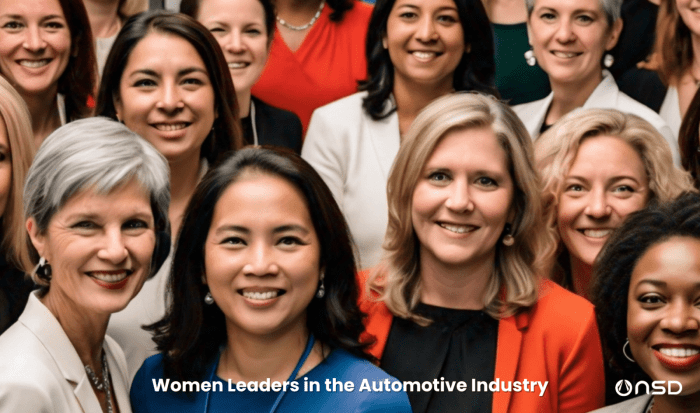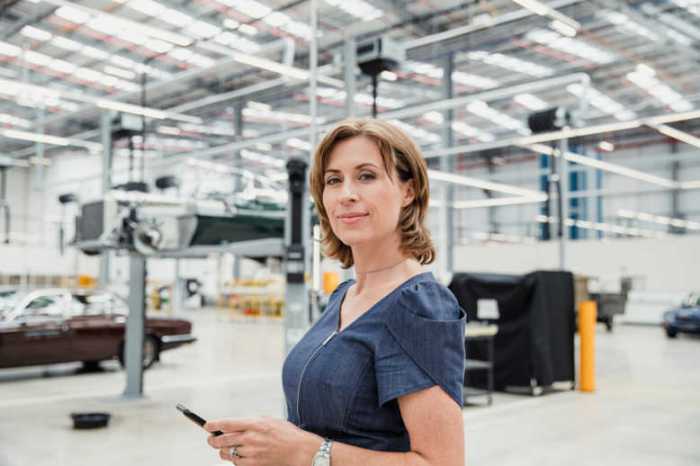Business women in automotive are driving innovation and change in a traditionally male-dominated industry. From early pioneers to today’s trailblazers, their contributions have been profound and impactful. This exploration delves into the historical context, current state, challenges, and success stories of women in automotive, highlighting the evolving roles and opportunities in this dynamic sector.
This overview examines the persistent challenges faced by women, including potential gender bias in hiring and promotion. We’ll also analyze the strategies for advancement, and how these women are paving the way for future generations. It’s a journey through inspiring stories and insightful analyses, exploring the crucial role of mentorship and support in fostering inclusivity.
Historical Context
The automotive industry, traditionally a male-dominated field, has seen a gradual yet significant shift in women’s participation over the decades. From early pioneers working behind the scenes to modern-day CEOs and engineers, women have consistently challenged stereotypes and carved out their place in this complex and dynamic sector. This evolution reflects broader societal changes in gender roles and opportunities.This historical overview explores the journey of women in the automotive industry, highlighting key milestones and tracing the changing perceptions of their roles.
The narrative spans from the early days of the automobile to the current era, showcasing the progress made and the ongoing challenges.
Early Pioneers and Emerging Roles
The early 20th century saw the initial emergence of women in the automotive industry, albeit in limited capacities. These early pioneers often worked in administrative roles, such as secretaries or receptionists, demonstrating a starting point for female participation. The limited opportunities available to women reflected the broader societal norms of the time, where women’s roles were often confined to domestic spheres.
Evolution of Roles and Opportunities
The mid-20th century witnessed a gradual expansion of roles for women in the automotive industry. As manufacturing processes became more sophisticated, women began to enter assembly lines and other technical positions. The growth of the automotive industry itself, combined with societal shifts towards greater gender equality, facilitated this evolution.
Societal Perceptions and Changing Attitudes
Societal perceptions of women in the automotive industry have significantly evolved. Early on, women were often viewed as secondary figures, primarily as supporting staff. However, as more women entered the workforce and achieved professional success in various fields, including automotive, these perceptions began to change. This shift was fueled by the growing recognition of women’s capabilities and their contributions to the overall success of companies and the industry as a whole.
Timeline of Key Milestones
- 1910s-1920s: Initial entry of women into administrative roles within automotive companies, often working as secretaries or receptionists. This was a nascent phase, reflecting limited opportunities and societal norms.
- 1930s-1950s: A gradual increase in women entering manufacturing roles, such as assembly line workers, often in lower-paying positions. This reflects the broader societal shift towards women entering the workforce.
- 1960s-1970s: Growing emphasis on equal opportunities, and women start to enter technical and engineering positions. The Civil Rights Movement and feminist movements played a crucial role in this evolution. Women started taking on roles in research and development, and design.
- 1980s-2000s: Significant advancements in women’s career paths in the automotive industry. More women started to hold managerial positions, including positions in leadership and executive roles. This era marks a significant increase in women’s participation in all levels of the industry.
- 2010s-Present: The automotive industry sees a rise in female CEOs and leadership positions. More women are involved in product development, engineering, and marketing, showcasing increasing opportunities for women at the forefront of innovation and leadership.
Impact of Technological Advancements
Technological advancements have significantly impacted women’s roles in the automotive industry. Automation and digitalization have opened new avenues for women to enter technical fields, such as software development and data analysis, within the automotive sector. This has led to a more diverse and inclusive workforce, reflecting a wider range of skills and expertise.
Current State of Affairs: Business Women In Automotive
The automotive industry, once a male-dominated landscape, is slowly but surely witnessing a shift. Women are increasingly taking on leadership roles and contributing meaningfully across various sectors within the industry, challenging traditional perceptions and paving new paths. This evolution presents exciting opportunities, yet it also brings forth unique challenges that require careful consideration and proactive solutions.The presence of women in the automotive industry is no longer a novelty, but a significant force.
From engineering and design to marketing and sales, their contributions are vital to the sector’s success. This section explores the current realities, focusing on the challenges and opportunities women face, while highlighting inspiring examples of female leaders and entrepreneurs who are making a difference.
Presence of Women in Automotive Roles, Business women in automotive
The automotive sector, traditionally dominated by men, is now seeing a rise in the number of women in various roles. While progress has been made, the representation of women is not uniform across all job categories. Significant disparity still exists in some areas, particularly in senior leadership positions.
Challenges Faced by Women in the Automotive Sector
Women in the automotive industry face a unique set of challenges, often stemming from systemic biases and societal expectations. These challenges include a lack of mentorship opportunities, a gender pay gap, and a still-prevalent culture of exclusion. Furthermore, balancing work and family responsibilities can be particularly difficult in a demanding industry.
Opportunities for Women in the Automotive Sector
Despite the challenges, the automotive sector presents significant opportunities for women. The industry is undergoing rapid technological advancements, creating new roles and avenues for women to contribute. The rise of electric vehicles and autonomous driving, for example, requires specialized expertise in areas like software engineering, data science, and AI.
Examples of Successful Women Leaders and Entrepreneurs
Several women have carved successful paths in the automotive industry, demonstrating the potential and capabilities of female leaders. One prominent example is [Insert Name of a successful woman leader in automotive], who has excelled in [Specific area of expertise, e.g., automotive design]. Her leadership has inspired countless women to pursue careers in the industry.
Comparison of Women’s Representation in Automotive Job Categories
| Job Category | Percentage of Women | Challenges/Opportunities |
|---|---|---|
| Engineering | [Percentage from reliable source] | Often faces a lack of mentorship opportunities and gender stereotypes. Opportunities exist in developing electric vehicle technologies and autonomous driving systems. |
| Design | [Percentage from reliable source] | While growing, may still face underrepresentation in senior design roles. Opportunities lie in the creativity and innovation required in designing sustainable and technologically advanced vehicles. |
| Marketing | [Percentage from reliable source] | Challenges include navigating a traditionally male-dominated sales environment. Opportunities exist in developing marketing strategies for electric and sustainable vehicles. |
| Sales | [Percentage from reliable source] | Often faces a bias in negotiations or interactions. Opportunities in expanding customer segments and promoting sustainable vehicles. |
Note: Replace bracketed values with actual data from reliable sources. The table demonstrates a potential framework for analyzing representation across different roles.
Success Stories and Mentorship
Women have consistently demonstrated remarkable resilience and innovation in the automotive industry, navigating challenges and achieving remarkable feats. Their contributions have been crucial to the industry’s progress, and their stories deserve to be celebrated and shared. Mentorship plays a vital role in fostering future generations of successful women in automotive, building strong networks, and supporting career growth.Inspiring stories of successful women in automotive provide valuable insights and encouragement for aspiring professionals.
Understanding the paths taken by these pioneers helps to identify key strategies and demonstrate that success is achievable.
Women are increasingly making their mark in the automotive industry, bringing fresh perspectives to the table. They’re not just excelling in traditional roles; they’re also revolutionizing the customer experience, like reinventing the customer experience to create a more personalized and engaging journey. This innovative approach is helping shape the future of car buying, and business women in automotive are leading the charge.
Notable Women in Automotive
Successful women in the automotive industry have overcome obstacles and excelled in various roles. Their achievements often stem from a combination of hard work, dedication, and a supportive network. Examples include engineers who have designed innovative features, executives who have led companies to success, and entrepreneurs who have started their own automotive businesses. These women serve as role models for future generations of professionals, demonstrating that a career in automotive is accessible and rewarding for women.
Mentorship Programs for Women
Mentorship programs specifically designed for women in automotive offer invaluable support and guidance. These programs connect experienced women with aspiring professionals, providing a platform for sharing knowledge, expertise, and experiences. A structured program should offer regular meetings, workshops, networking events, and opportunities for career development.
Women are increasingly making their mark in the automotive industry, from design and engineering to sales and marketing. To succeed in this competitive landscape, savvy businesswomen need to leverage online strategies. This means understanding crucial aspects of ecommerce, like optimizing their online presence for speed and user experience. Knowing how to improve ecommerce core web vitals is essential for attracting and retaining customers, which directly benefits their automotive businesses.
Ultimately, mastering these online elements is key for the success of these forward-thinking businesswomen.
Framework for Effective Mentorship Programs
Establishing a robust mentorship program requires a clear framework. A crucial aspect is identifying suitable mentors, individuals with demonstrated success in the automotive industry and a proven commitment to supporting women. Potential mentors should possess a genuine interest in guiding and empowering women in their careers. Furthermore, the program must provide comprehensive training for both mentors and mentees, emphasizing effective communication, active listening, and mutual respect.
This structured approach fosters a supportive and productive environment for all participants.
Women are making significant strides in the automotive industry, breaking barriers and proving their mettle. Their innovative ideas are transforming the sector, but the future of automotive might also be deeply intertwined with AI. Google’s recent Q4 earnings, highlighting a focus on AI advancements like in googles q4 earnings point to an ai focused future , suggest a potential shift in how vehicles are designed, manufactured, and driven.
This will likely influence the way these pioneering women navigate the future of the automotive industry, making it all the more exciting to watch their impact unfold.
Importance of Female Representation in Leadership
Increased female representation in leadership roles within the automotive industry is essential for fostering inclusivity and innovation. Women bring diverse perspectives, experiences, and approaches to problem-solving, which can lead to more creative solutions and better decision-making. Companies that prioritize female representation in leadership positions often experience higher levels of innovation, improved employee morale, and enhanced overall performance. This demonstrably positive impact highlights the importance of creating an environment where women feel valued and empowered to take on leadership roles.
Strategies for Advancement
The automotive industry, while experiencing significant growth, continues to face challenges in achieving gender parity. Strategies for advancement are crucial not only for promoting equity but also for unlocking the full potential of the workforce. Innovative approaches are necessary to increase female representation, foster inclusivity, and create a supportive environment for women to thrive.Effective strategies to increase participation of women in the automotive industry require a multifaceted approach that addresses various aspects of the industry’s ecosystem.
This includes fostering a culture of inclusivity within companies, offering targeted educational and training programs, and creating mentorship opportunities. This multifaceted approach can empower women, leading to a more diverse and productive workforce.
Recruitment and Retention Strategies
Attracting and retaining women in the automotive industry requires a deliberate effort to address systemic barriers and create a welcoming environment. Companies must actively seek to recruit qualified female candidates from diverse backgrounds. This can be achieved through targeted outreach programs, partnerships with educational institutions, and showcasing successful female role models within the industry.
- Targeted Recruitment Campaigns: Developing recruitment campaigns specifically aimed at attracting women can be highly effective. These campaigns should highlight the opportunities available to women in the industry and showcase successful female professionals.
- Mentorship and Sponsorship Programs: Mentorship programs that connect experienced female professionals with aspiring women can provide valuable guidance and support. Sponsorship programs, where senior executives actively advocate for the advancement of women, can also significantly enhance career progression.
- Flexible Work Arrangements: Offering flexible work arrangements, such as remote work options and flexible hours, can be crucial in attracting and retaining women. This consideration acknowledges the diverse needs and responsibilities women often face, demonstrating the company’s commitment to inclusivity.
- Creating a Supportive Culture: Establishing a culture that values diversity and inclusion is essential. This can involve implementing policies that promote equal opportunities, addressing workplace biases, and fostering open communication.
Educational and Training Initiatives
Investing in educational and training programs that cater to women’s needs is crucial for enhancing their participation in the automotive industry. Such programs should be designed to address specific skill gaps and career aspirations, equipping women with the necessary knowledge and competencies to thrive in this field.
- Specialized Training Programs: Developing specialized training programs that focus on specific automotive skills, such as engineering, design, or manufacturing, can equip women with the technical expertise needed to excel in the industry.
- Scholarships and Financial Aid: Providing financial assistance through scholarships and grants can make education more accessible for women from diverse backgrounds, fostering their participation in automotive-related programs.
- Networking Opportunities: Facilitating networking opportunities between women in the industry can be crucial. These networks can provide support, mentorship, and opportunities for collaboration and knowledge sharing.
Promoting Diversity and Inclusion in the Workplace
Promoting diversity and inclusion within the automotive industry is critical for creating a welcoming and supportive environment for women. It’s not just about hiring more women; it’s about creating an inclusive environment where women feel valued and empowered to contribute their unique perspectives and skills.
- Bias Training for Employees: Implementing bias training programs for all employees can help raise awareness of unconscious biases and promote a more equitable work environment.
- Employee Resource Groups (ERGs): Creating employee resource groups (ERGs) specifically for women can provide a platform for networking, support, and advocacy within the workplace.
- Promoting Inclusive Language and Practices: Promoting the use of inclusive language and practices in the workplace can create a more welcoming environment for women and other underrepresented groups. This may include using gender-neutral language in job descriptions and company communications.
Future Outlook
The automotive industry is poised for a period of significant transformation, driven by technological advancements and evolving consumer needs. This shift presents both challenges and opportunities for women in the sector. Understanding these trends and the potential impact on women’s roles is crucial for navigating the future landscape effectively.The future of the automotive industry is intrinsically linked to technological innovation.
Electric vehicles, autonomous driving, and connected car technologies are reshaping the industry’s core, demanding new skills and perspectives. This evolution necessitates a re-evaluation of traditional roles and a proactive approach to ensure that women have the chance to contribute to these developments.
Future Trends in the Automotive Industry
The automotive industry is experiencing a rapid evolution, moving away from traditional internal combustion engines towards electric vehicles (EVs) and autonomous driving. This transition is impacting manufacturing processes, research and development, and even the design aesthetic of vehicles.
- Electric Vehicle Dominance: The shift towards EVs is already underway, with major automakers investing heavily in battery technology and charging infrastructure. This trend will likely accelerate in the coming years, leading to a significant increase in demand for engineers specializing in battery management, power electronics, and electric motor design. For example, Tesla’s rapid growth demonstrates the increasing market share of electric vehicles.
- Autonomous Driving: The development and deployment of autonomous driving technology is a major focus for many automotive companies. This area requires expertise in sensor technology, artificial intelligence, and software engineering. The integration of autonomous features will create new job roles and require specialized skillsets.
- Connected Car Technologies: The increasing connectivity of vehicles allows for a more personalized and integrated user experience. This involves significant advancements in software development, data analysis, and cybersecurity. The development and integration of these technologies will create new job opportunities.
Potential Impacts on Women’s Roles
The evolving landscape of the automotive industry will undoubtedly impact the roles of women. The need for a diverse workforce, skilled in the new technologies, is paramount. Companies that prioritize diversity and inclusion will be better positioned to innovate and compete.
- Increased Demand for Specialized Skills: The shift towards EVs and autonomous vehicles necessitates a skilled workforce with expertise in areas like battery technology, software engineering, and AI. Women with existing skills in these areas can leverage their expertise to pursue new roles. The rise of the “car tech” sector has already seen the demand for such skills increase.
- Emphasis on Innovation and Design: Women bring unique perspectives and creative problem-solving abilities to the table. The future of automotive design will likely be shaped by their insights and experiences, which is important for addressing the needs of a broader consumer base.
- Need for Mentorship and Networking Opportunities: As the industry evolves, mentorship and networking opportunities for women in the automotive sector will become even more crucial. Women can leverage these connections to build their careers and advance within the company.
Diversity and Inclusion in Design and Development
Creating vehicles that meet the needs of a diverse range of users requires a diverse team of designers and engineers. The importance of including various perspectives and experiences is vital for developing vehicles that are truly inclusive and accessible.
- Accessibility Features: Designing vehicles for individuals with disabilities is becoming increasingly important. Diverse teams can ensure that vehicles are designed with accessibility in mind, incorporating features that cater to a wide range of needs.
- Cultural Sensitivity: Vehicles need to reflect the diverse needs and preferences of global consumers. Incorporating diverse design teams is critical for creating vehicles that are culturally sensitive and resonate with a global audience.
Forecast for the Future of Women in the Automotive Industry
The future of women in the automotive industry is bright, contingent upon proactive strategies to encourage participation and advancement. Women can play significant roles in shaping the future of the automotive industry.
- Increased Representation: Companies that prioritize diversity and inclusion will be more successful in attracting and retaining talented women. This increased representation is vital for driving innovation and success in the sector.
- Leadership Roles: Women are already making significant contributions in the automotive industry. Their presence in leadership positions will continue to grow as the industry embraces innovation and diversity.
Industry Specific Roles

The automotive industry, a complex and dynamic sector, presents diverse opportunities for women in various roles. From the design of sleek, innovative vehicles to the meticulous engineering that underpins their performance, and the strategic marketing that shapes their appeal, women are increasingly making their mark. This section delves into the specific roles women occupy within the automotive industry, highlighting the unique challenges and opportunities they face, and advocating for the support systems needed to foster their success.The automotive industry is undergoing a significant transformation, driven by technological advancements and evolving consumer preferences.
This evolution creates new pathways for women to contribute their skills and expertise, while simultaneously presenting unique obstacles that need to be addressed.
Automotive Design
The automotive design process is a collaborative effort that demands creativity, technical acumen, and a strong understanding of aesthetics. Women in automotive design bring unique perspectives to the table, fostering innovative solutions and creating vehicles that appeal to a broader customer base. Their contributions can be seen in the design of more user-friendly interiors, the development of aesthetically pleasing exterior designs, and the incorporation of sustainable materials.
Challenges include navigating a traditionally male-dominated environment and the need for mentorship and networking opportunities to advance within the design field.
Automotive Engineering
Engineering in the automotive sector encompasses a vast spectrum of specialized disciplines, from mechanical and electrical engineering to software development and testing. Women engineers are instrumental in ensuring the safety, efficiency, and performance of vehicles. Specific roles include developing advanced engine technologies, creating innovative braking systems, and designing advanced driver-assistance systems (ADAS). Challenges include the need for more inclusive hiring practices and the need for flexible work arrangements that accommodate family responsibilities.
Opportunities lie in the growing demand for female engineers in the sector, particularly in emerging fields like electric vehicle technology.
Automotive Manufacturing
Manufacturing is a critical aspect of the automotive industry, requiring a combination of technical expertise and logistical efficiency. Women in manufacturing roles contribute to every stage of the production process, from quality control to assembly line operations. Specific roles include production planning, quality assurance, and supply chain management. Challenges include balancing the demands of the manufacturing environment with personal commitments.
The need for dedicated training and support programs, including leadership development programs, is crucial for women in manufacturing to advance.
Automotive Sales
Automotive sales presents a unique opportunity for women to excel in customer service and relationship building. Women in sales roles often possess exceptional communication and interpersonal skills, enabling them to effectively connect with clients and build trust. They can excel in roles like sales representatives, account managers, and business development executives. Challenges include combating gender bias in negotiations and the need for supportive management structures.
Opportunities lie in the ability to build rapport with clients and to leverage a diverse skill set to thrive in this field.
Automotive Marketing
Marketing in the automotive industry involves a complex interplay of branding, advertising, and public relations. Women in marketing roles are vital for shaping consumer perception of vehicles. Specific roles include marketing managers, product managers, and brand ambassadors. Challenges include balancing the demands of a fast-paced environment with personal priorities. Opportunities lie in the ability to leverage creativity and innovation to develop compelling marketing campaigns and create a positive brand image.
Comparison of Typical Career Paths
| Aspect | Typical Male Career Path | Typical Female Career Path |
|---|---|---|
| Early Career | Focus on technical expertise and rapid advancement through specialized roles. | Often focuses on generalist roles to gain experience and build a strong foundation. |
| Mid-Career | May transition to leadership roles or specialized engineering positions. | May transition to management positions or focus on specialist roles. |
| Career Advancement | Generally, perceived as easier to advance in male-dominated sectors. | Often faces obstacles like unconscious bias and a lack of mentorship. |
| Work-Life Balance | Often requires more sacrifices regarding work-life balance. | Requires more planning and strategies to accommodate family commitments. |
The table illustrates that while both men and women may pursue similar career paths, the experiences and challenges can differ significantly. A supportive environment that promotes inclusivity and flexible work arrangements is crucial for women to achieve success in the automotive industry.
End of Discussion

In conclusion, the journey of business women in automotive is one of resilience, innovation, and empowerment. While challenges remain, the rising tide of female representation in this industry promises a brighter future, marked by diverse perspectives and groundbreaking solutions. This exploration emphasizes the importance of continued support, mentorship, and proactive strategies to unlock the full potential of women in automotive, leading to a more inclusive and successful future for all.






